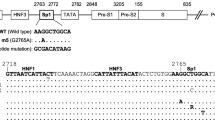Summary.
The HBV in the sera of two chronic active hepatitis patients were analyzed for the promoter sequence heterogeneity. In most cases, the proportion of any particular clone in the total viral populations was less than 50%, showing high mutation rates. In contrast, promoter sequences of HBV from asymptomatic carriers revealed only a few point mutations with no deletions. HBV in chronic patient harbored variants with multiple mutations throughout promoters including 1762 (A-to-T), 1764 (G-to-A) double mutation in C promoter and deletions near CCAAT site in S promoter. Unlike other three promoter regions, C, pre-S1 and S, of HBV which revealed a high level of sequence heterogeneity, the X promoter region (from nt 985 to 1430) showed little sequence heterogeneity within a patient. However, the predominant viral clones in two patients were quite different from each other. In addition to mutations in promoter regions, a deletion mutation in the translation start codon was also found in pre-S1 gene. The results in this report indicate that the mutation rates are not the same in all four promoters and that one of the strategies for maintaining persistent infection could be through mutations in viral promoters which then impair the balance of viral gene expressions.
Similar content being viewed by others
Author information
Authors and Affiliations
Additional information
Accepted July 6, 2000
Rights and permissions
About this article
Cite this article
Ha-Lee, Y., Lee, J., Pyun, H. et al. Sequence variations of hepatitis B virus promoter regions in persistently infected patients. Arch. Virol. 146, 279–292 (2001). https://doi.org/10.1007/s007050170175
Issue Date:
DOI: https://doi.org/10.1007/s007050170175




